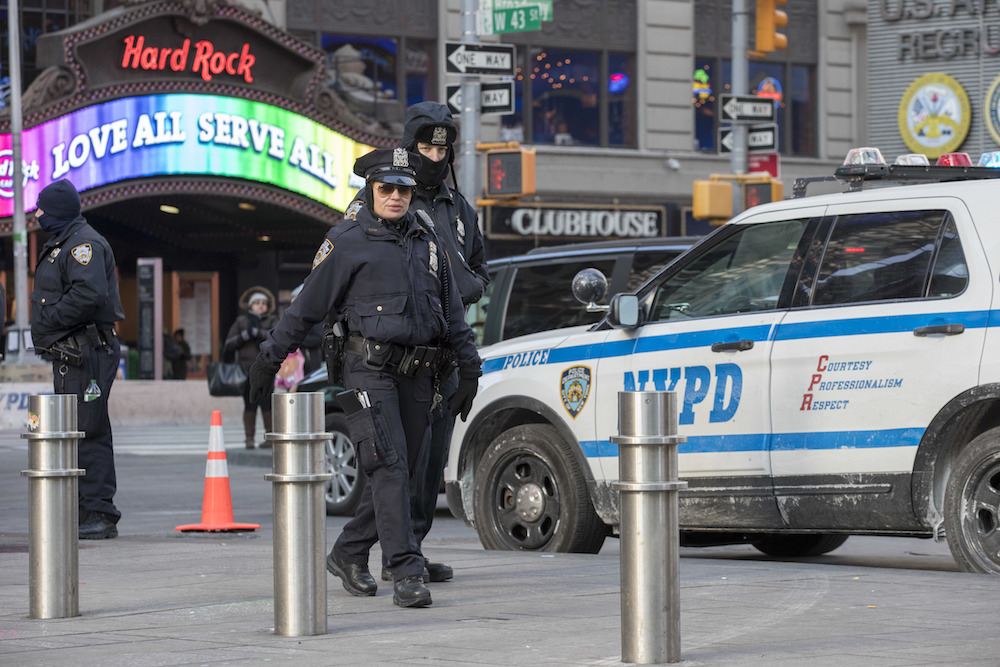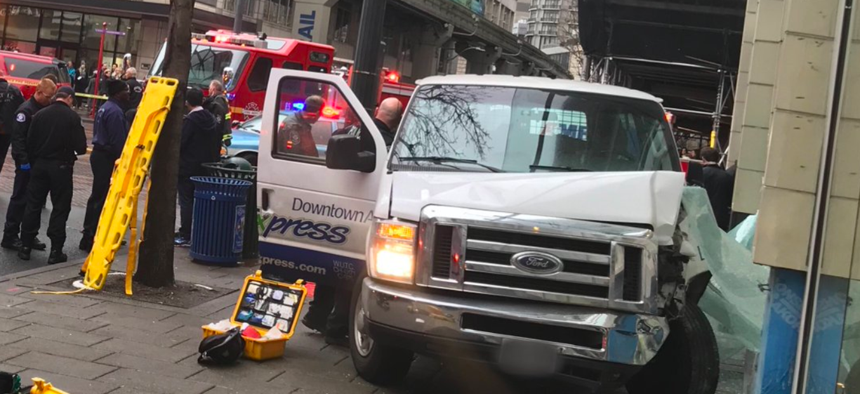Connecting state and local government leaders
Bollards and barriers can help protect pedestrians and crowds from malicious and unintended acts by motorists but can also limit walkability and pose their own hazards and nuisances.
SEATTLE — In late December, a person driving an airport shuttle van experienced a medical emergency and jumped the curb near the flagship Nordstrom department store in the heart of the Emerald City’s retail core, striking four pedestrians on the sidewalk before ending up in The Gap’s storefront window. In total, six people were sent to local hospitals, including pedestrians with serious and critical injuries.
There were early moments when it was thought that the incident in downtown Seattle could have been an act of terrorism, but local police soon said there was "nothing obvious to make this an intentional act or deliberate.” National interest in the situation quickly faded. It was yet another instance where a person driving a vehicle hit a pedestrian or a crowd of pedestrians—a problem that’s all too common in the United States yet doesn’t always get the attention it deserves.
Locally, the incident raised questions about whether bollards—poles that are usually metal, often positioned at intervals along sidewalks and designed to stop vehicles that leave the roadway from striking pedestrians—might have prevented injuries.
Similar questions were asked this past fall after a deadly incident where an Uzbek man stands accused of driving a truck along a popular bicycle and jogging path near the World Trade Center in lower Manhattan and killing eight people and injuring 11 more. Authorities called that incident an act of terror, the deadliest such attack in New York City since Sept. 11, 2001.
On Tuesday, Mayor Bill de Blasio announced that New York City would expand the use of bollards in Times Square and at other locations around the city in the next few years. According to WABC-TV, the city will spend $50 million on the new permanent bollards, many at sites that currently have temporary protections, including large concrete barriers.

The need is apparent in crowded, high-profile locations in New York City, like outside the Empire State Building, where temporary—but decorated—barriers protect sidewalks adjacent to the landmark skyscraper popular with tourists.
Last July, a man with a history of mental health issues drove through a crowd of people in Times Square, killing one person and injuring 22 more.
But it doesn’t take a terrorist attack or other intentional act to create a mass-casualty tragedy on the nation’s streets, sidewalks and recreation trails.
In 2003, an 86-year-old man driving a car killed nine people at a popular farmers market in Santa Monica, California. The elderly man told police he had mixed up his Buick’s brake with its accelerator. "It was like a Sherman tank barreling through, hitting everything, just going right over people,” a witness told CNN at the time.
Farmers markets, which often occupy streets that are temporarily closed off with barricades, usually don’t come with heavier obstructions that could prevent a repeat of the Santa Monica tragedy—or something worse like the 2016 Bastille Day truck attack along the Promenade des Anglais in Nice, France, a horrific act that killed 86 people and injured more than 400 others.
Many street festivals and other public gatherings in cities across the nation face similar vulnerabilities.
Following deadly attacks on crowds using vehicles in London, the French Riviera and Charlottesville, Virginia, some local law enforcement agencies in the U.S. have used public works vehicles, like garbage trucks, as protective blockades at special events, National Public Radio reported in September.
In the security response to the Sept. 11, 2001 terror attacks, it wasn’t uncommon to see authorities in Washington, D.C. use out-of-service Metrobuses to block approaches to the U.S. Capitol during a State of the Union address to deter truck-bomb attacks. There are now permanent movable barricades that can rise out of the street pavement to block off access to areas of the congressional campus when needed, reducing the risk of a bomb carried by a vehicle from reaching the Capitol and its adjacent office buildings.
While there are still plenty of bulky post-9/11 concrete barriers, fences and planters protecting sidewalks and approaches to government office buildings and high-profile landmarks around the nation’s capital, there are many bollards and other lower-profile sidewalk protections that have been installed since the terrorist attacks and have mostly blended into D.C.’s streetscape.
But depending on placement, bollards can create pinch points for pedestrians trying to navigate sidewalks and others pushing strollers and making deliveries.
Many bicyclists view bollards along recreational paths as hazards. Bollard-involved bicycle crashes have not only led to injuries, they’ve led to litigation, too.
According to Bicycle magazine:
“It’s very important that they design and construct these dedicated bike lanes safely,” Chris Davis, a personal injury lawyer representing Schwartz, told Bicycling. “The federal government recommends against using bollards because cyclists hit them all the time.”
The American Association of State Highway and Transportation Officials (AASHTO) warns against installing bollards on trails unless there is a specific need for them. If bollards are absolutely necessary—at intersections where car traffic might cross the trail, for example—AASHTO recommends that they be clearly marked and reflective.
In the case of last fall’s terrorist attack in New York City, if bollards had been installed at the spot where truck entered the bicycle and jogging path near the World Trade Center, a tragedy could have been averted.
In many places, local agencies have to figure out how to strike the right balance between security and the ease of mobility.
In Seattle, one local urbanist noted on Twitter that bollards aren’t necessarily a good design element to encourage walkable communities and that cities shouldn’t design sidewalks and other public spaces with “freak chance accidents,” like the one from last month, in mind.
Reacting to de Blasio’s announcement on Tuesday, Brookline, Massachusetts-based city planner and walkability advocate Jeff Speck made this important observation: “Whether this is a good or a destructive plan will essentially depend on whether the bollards are lovely or not.”
That’s important to keep in mind. Bollards, when well designed and sited, can be sensible additions to public spaces, and improve security without too much of an impact on mobility.
Still, there’s simply no one-size, fits-all solution to designing streets, sidewalks and public spaces that can protect pedestrians in all instances, except perhaps for one: eliminating cars. But that’s a tough proposition in urban environments that are often designed primarily with motorized vehicles in mind, not people.
Michael Grass is Executive Editor of Government Executive’s Route Fifty and is based in Seattle.

NEXT STORY: All states opt in to FirstNet




